This is a 3-part on how to play and effectively use chord inversions.
- Part 1 – [You Are Here] – What Are Piano Chord Inversions
- Part 2 – Piano Chord Inversions Explained in Simple Language
- Part 3 – How to Play Chord Inversions on the Piano
Piano Chord Inversions will help you get the most out of playing chord piano.
Chords are the foundation and structure of a song. It gives you the basic progression of the song allowing you to play a song quickly and easily. The problem with chords is that they lack the flare and important elements in the song.
Chords give you the basic information of the song. It gives you a 30,000 foot view of the song. A vague overview of what needs to be played.
Chord progressions are great because they make it much easier to play songs that have large jump from chord to chord. They also help you add more uniqueness to a song. Rather than just playing a simple chord progression, you can add different inversions into the song to give different sounds and texture to the song.
What is an inversion
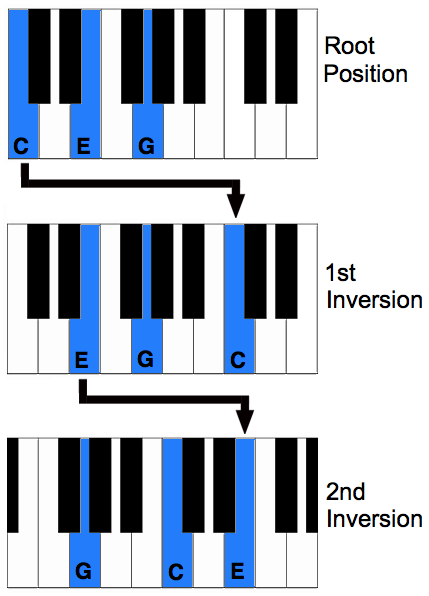
Piano chord inversions are taking any piano chord and shifting it up or down the piano.
The notes in the chord don’t change, but the position or place on the keyboard are different.
From our lesson on the piano keys, we learned that the notes on the keyboard repeat themselves all the way up and down the piano. Instead of playing a chord in its original position, you can play it with the same notes, just inverted to a different position.
Take a look at the image and you can see how the bottom note in the chord is being moved to the top of the chord. This is the basics of chord inversions.
Why Use Inversion
Chord Jumps
Piano Chord Inversions are helpful when playing songs that have chords that jump around a lot. What I mean by jump around is, they require you to make a pretty big jump from one position to another to play the chord.
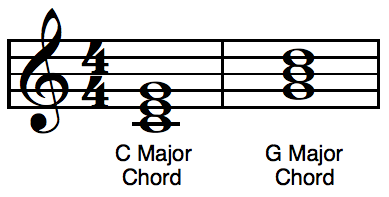
If you look at the image you can see that moving from the C Major Chord to the G Major Chord is a decent jump. You have to pick your hand up and move a large distance to play the G chord.
Inversions are great to help eliminate this problem. Instead of picking your hand up and moving it to whole new place on the piano, you can just play an inversion and you hand stays in the same place!
Voicings
A great thing that piano chord inversions do to your playing is they add different voicings to your music.
A voicing is when a musician rearranges the notes in a chord in a different order.
Why is this important!?!?!
It makes the song you are playing sound more natural. If you played a song with the chords C major and G major, and always played them in the same way the entire song, it would sound dull and amateurish.
What makes these voicings so great is that it almost changes the sound of the chord. Listen to the three inversions in the audio file. They are the same C Major Chord, just played in different inversions.
They all sound a little bit different. Using piano chord inversions, you can play the same chord progression and make it sound totally different by using the different voicings of the inversions.
Lets stop talking about inversions….. Let’s make them!
Inverting 3 Note Chords
Let’s look at inverting three note chords first. These are the most common chords used and the easiest to make piano chord inversions with.
To make a piano chord inversion, the bottom note in the chord is moved from the bottom of the chord to the top of the chord.
Let’s look at an example using the C Major Chord
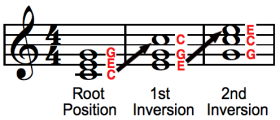
For the first inversion, the C note at the bottom of the chord is moved to the top. The other two notes stay the same.
For the second inversion, the E on the bottom is moved to the top and other two notes stay the same.
In all three of the inversion, the notes do not change. All that changes is the position in which you play the note. To play an inversion, you never change the notes of the chord, just where they are played.
Types of Inversions
There are three different inversions for each chord. Because there are three notes in the chord, there are three possible inversions.
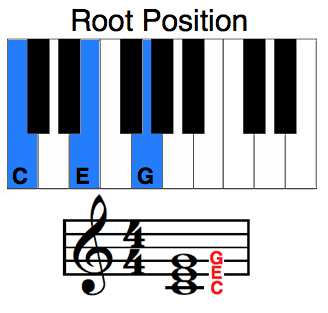
Root Position
The main inversion that most players know is the root position. Root position is the standard voicing for the the chord. It starts on the root note and plays the other two notes in the chord above it.
It is called root position because the note in which the chord is named is called the root. Like the root of a tree, the root note is the base in which the chord is built.
Click here for more information on major chords!
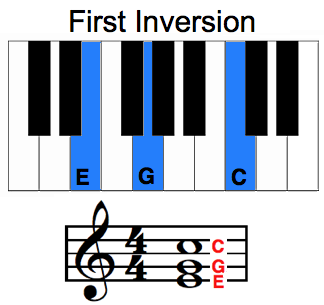
First Inversion
When you move the root note to the top of the chord you have made the first inversion. Instead of paying the root note at the bottom of the chord, you are now playing it at the top.
It’s known as the first inversion because it is the first transition from the the original root position.
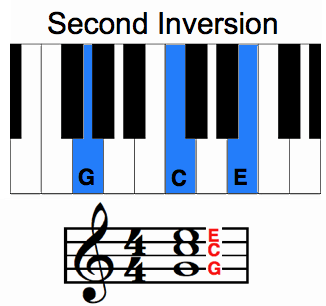
Second Inversion
The last inversion takes the the third middle note in the chord and makes it the bottom note. In the example, the G is now the lowest note in the chord. The E is now on the top of the chord.
Bass Clef Inversions
Most of the time, when using piano chord inversions you play them in the right hand or treble clef. Even though they are most commonly used with the right hand, they are still good to know for the left hand also.
Bass Clef Inversion follow the same principle, instead they use bass clef notes.
Look at the image and you can see that the same process is being used in the bass clef. The bottom note is being switched to the top of each of the chords. The notes are staying the same, but the position is different.

Learning inversion with the left hand can make the chord really sound unique. Instead of playing the same bass note every time you play a chord, you can change it and play the third note as the lowest bass note.
Quick Tip!
Want to make a boring chord progression sound unique? Use a different left hand inversion. Play the first inversion in stead of the root inversion and it will make the sound of the arrangement almost totally different!
Fingering
Right Hand Inversion Fingering
Inversions in the right hand have a different fingering than in the left hand. For the best transition and feeling for these inversion you need to lay them with the following fingering.
The Root Inversion stays the same as a regular major chord. I uses the thumb, middle finger, and small finger.
The First Inversion is a little different. Using the thumb and small finger, but the middle note should be played with the index finger, or second finger) instead of the middle finger. This is a whole lot more comfortable then trying to play it with the third finger.
The last inversion is going to be played with the same fingering as the root position fingering.

Left Hand Inversion Fingering
The left hand has its own way of playing these piano chord inversions. The root position and first inversion is going to be played the same. Use the fifth, third, and first fingers in the left hand to play those inversion
For the second inversion it gets a little different. Use the first and fifth fingers, but for the middle note, use the second, or index finger.
These fingerings are not very different from each other, but it is important to play each of them correctly or the will feel awkward when you play them.

Four Note Piano Chord Inversions
Making an inversion with a four note chord is exactly the same as three note chord. The only difference here is that there are a lot more combinations that you can make with a four note chord then a three note chord.
To see all the differences, just move the bottom note to the top of the chord. You will see that there are a lot of different unique sound you can make here. Try out as many as you can to see all the cool sound you can get.
What Next
Once you have them mastered go ahead and add them into you songs. You will be surprised how much better they will sound. Not only will they sound better, but they will be easier to play. Instead of moving your hands all over the place, you can comfortably play the chords you want in a small area on the piano.
Piano Chord Inversions are great to add your own unique personality to a song. Instead of playing all the same boring chords, add these inversion in and see how your songs evolve from plain to extraordinary!
